Disclosure: Meeple Mountain received a free copy of this product in exchange for an honest, unbiased review. This review is not intended to be an endorsement.
900 years before Johannes Gutenberg invented the printing press, the only way to ensure that a written text was mass produced was to physically make copies by hand. While there were many cultures engaging in the practice, perhaps the most well known examples were those created by the monastic scribes at the time. Each book was lovingly crafted in a scriptorium by a team of monks, some dedicated to the transcription, others to the illumination (i.e. the beautiful artwork and filigree often found in these olden texts). Very rarely a singular monk might have been responsible for both.

Overview
Biblios: Quill and Parchment (Biblios Q&P) is a roll and write game that drops the players into one of these scriptoriums. Before them lie various texts on a variety of subjects that they are in charge of copying. However, players also have to balance their religious pursuits with these responsibilities. Some texts bear more importance than others (religious texts are more important than bestiaries, for example) but this can be manipulated during the course of the game. When the game ends, the players will earn points based on how many of each specific type of text they have produced and also how many points those are worth. Other sources also provide points — how far the player’s novice has traveled across the land in search of new manuscripts, how much piety they have gained, and bonuses for being one of the first to copy a certain number of books, to name a few. Once all of the points have been tallied, the monk with the most wins the game.
This is a high level overview, of course. If you’d like to skip the gameplay, feel free to skip ahead to the Thoughts section. Otherwise, read on to find out how to play Biblios: Quill and Parchment.
Setup
First the players should determine whether they are going to play the basic or advanced mode. Each player receives a Task card (i.e. player mat) which they will flip to the appropriate side as well as a dry erase marker, 1 Travel die, 2 Influence dice, and 3 Book dice. Then the Monastery card (the central game board) is placed face up on the appropriate side with the Value dice placed into their appropriate locations with the following starting settings: blue = 4, grey and pink = 5, and green and red = 2. The purple Embellishment die is set aside for the time being.
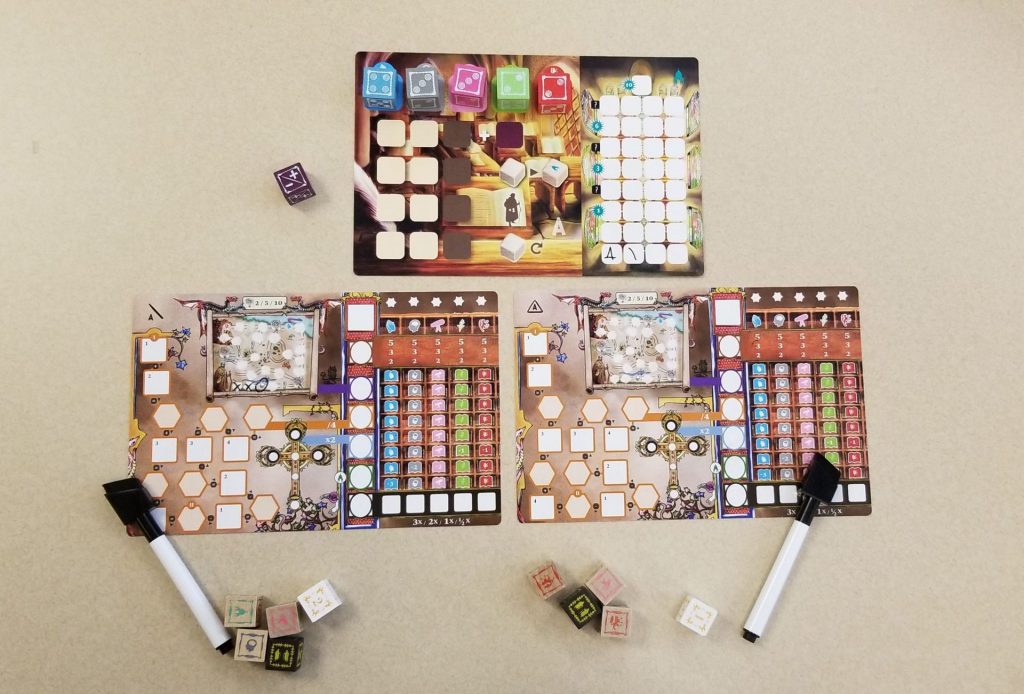
Each Task card has a letter in its upper left corner (representing the difficulty) and next to this is a unique symbol. Each symbol is used to represent the player that owns that specific Task card. Beginning with the oldest player to the youngest, the players each draw their symbol into the first available empty slot of the lowest row of church pews in the chapel on the Monastery board. For the rest of the game, whoever is furthest ahead (highest row and furthest to the left) will always win tie breakers and will be considered the first player.
With that, you are ready to begin playing Biblios Q&P.
Period I
The game is played over a total of 8 rounds divided into 2 periods of 4 rounds (called ‘days’) each. Each day is further divided into several steps. In the first period, the days consist of the following steps:
- Matins: the players roll all of their dice and then have the opportunity to re-roll either all of the dice, a single die, or no dice. They are permitted a total of 2 re-rolls and once a player has decided to stop re-rolling, they must work with what they currently have.
- Lauds: the players use their chosen dice…
- to copy books by marking off a book icon of the appropriate color. If the player is the first to mark off all of the books of a specific icon, they will circle the highest bonus. Later players marking off all books in the same column will collect the next highest bonuses.
- to move their Novice along the map track. Each time they cross over or land on a bonus, they mark off a book icon of the appropriate color. Each town visited gets marked off and will score points at the end of the game. Any ? icons encountered will allow the player to roll a Book die and mark off a book icon of the appropriate color or move up in the chapel if that symbol appears.
- to go to the chapel during the Vespers step.
- to accumulate Abbot influence. The numbers on the Influence dice are added together and the total is recorded in that day’s box on the Task card.
- to either fill in a circle on the cross or move the Novice one space along the map track if one of the dice cannot be used any other way. For instance, if a player rolls a blue Book die but has already filled up their blue book column, they could choose one of these other options instead.
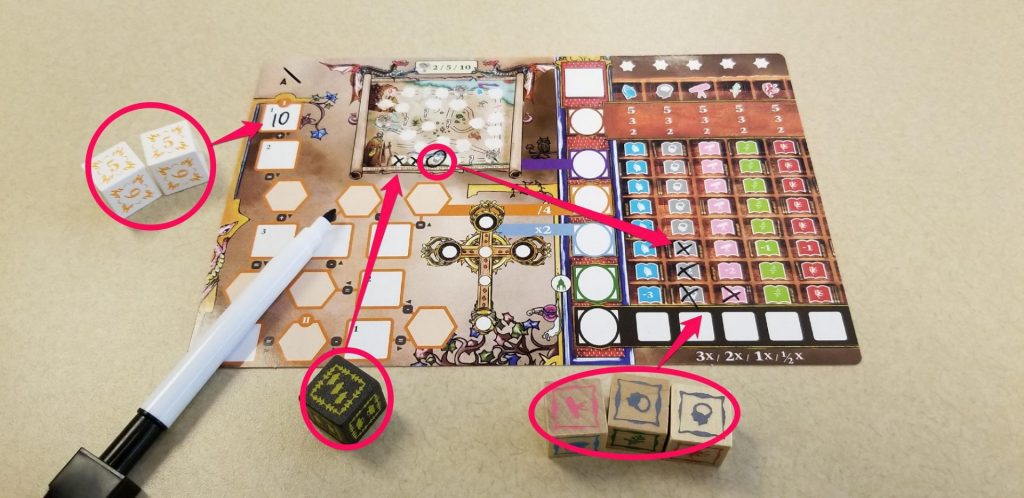
- Vespers: the players take turns going to chapel one Chapel die at a time. The player that rolled a chapel symbol and is furthest behind and closest to the right in the chapel goes first. They draw their icon in the next available row in the leftmost empty space. Then other players follow suit. To the left of some of the rows are numbers which represent the victory point totals a player will earn if they end the game in or past that row, but they will only earn points for the highest number they have reached. If a player reaches a row with a ? next to it, they will roll a Book die and mark off a book icon of the appropriate color or move up in the chapel if that symbol appears.
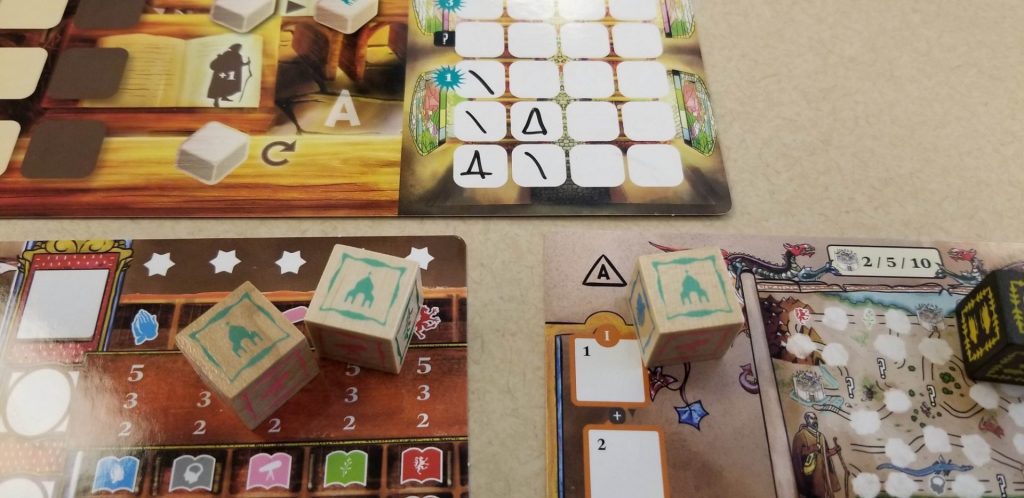
Period II
Each day of the second period consists of the following steps:
- Vigils: the players prepare the Scriptorium by rolling the dice shown on the Monastery card (one row, from the top down, per player) and then placing the rolled dice into their locations.
- Prime: the players secretly bid some amount of the Abbot influence collected during the first period by writing their bid into the box matching the current day and covering it with their hand. Once all players have written their bids, they reveal them. The bid amount is deducted from the current total and the new total is recorded. Ties are broken by the player closest to the altar.
- Terce: from highest to lowest bidder, the players take turns choosing a row of dice, performing their associated actions (see the Lauds section) and then optionally performing the bonus action associated with the row. Those bonus actions in order from top row to bottom are:
- Embellish a book: if the + is showing on the Embellishment die, then one of the Value dice can have its pip value adjusted by 1 to a maximum of 6. The opposite is true if a – is showing. If both are showing, then 2 different dice can be affected (or even the same die). Using the Embellishment die is the only bonus action that is not optional.
- Go to chapel: the player may turn one of their collected Book dice to the chapel facing and then move forward in the chapel (see the Vespers section).
- Travel further: the player may move their Novice ahead one space on the map (see Lauds).
- Change plans: the player may reroll one of their book dice but must use the result regardless of what it is.
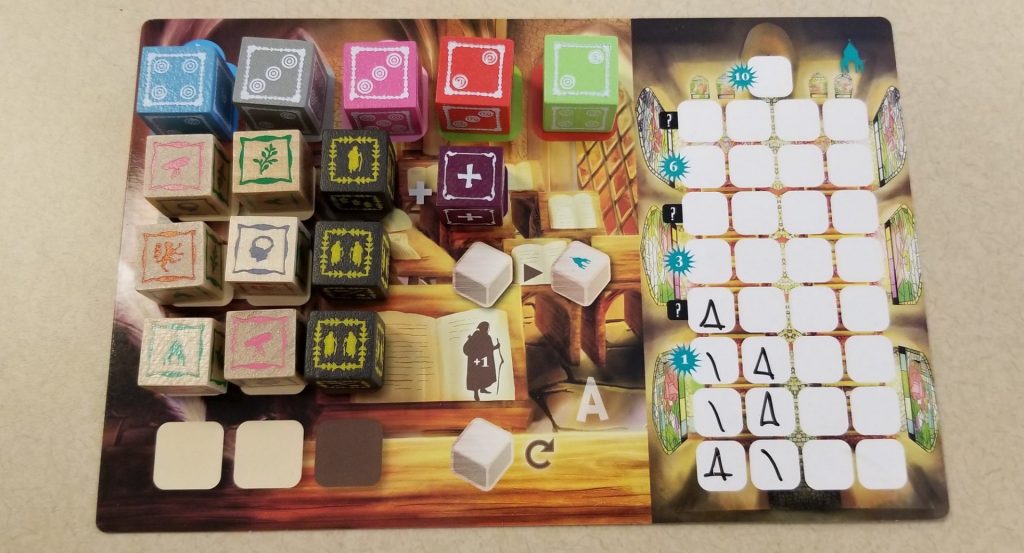
Revelations
This is it. The end of the game. Once the 8th day has been completed, the players will tally their scores and whoever has the highest total will win. Scores are tallied thusly:
- The players count up the total number of books that they have marked off in a column. The player with the highest total scores 3 times the current value of the matching Value die with second and third place receiving less rewards. Ties are broken by who is closest to the altar. Each column of books is considered separately.
- Two points are earned per circle filled in on the cross (see Lauds).
- Points are earned by dividing the remaining Abbot influence by 4 (rounding down).
- The Novice earns 2/5/10 if it visited 1/2/3 cities during its travels.
- Chapel points are awarded (see Vespers).
- The requisite amount of points are awarded to players that reached the top of a book stack and earned bonuses for doing so (see Lauds).
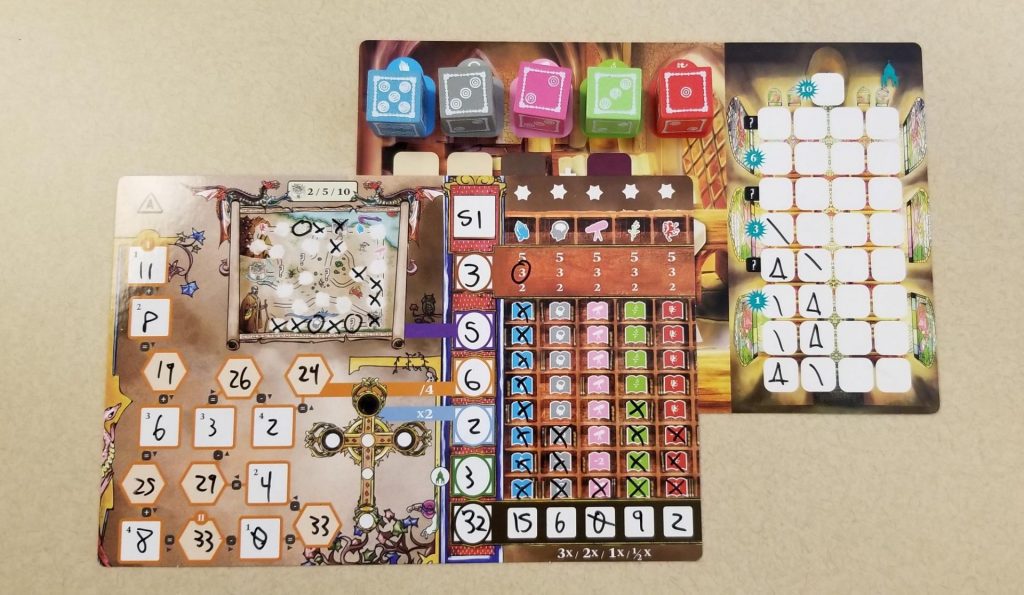
Different Ways to Play
The rules outlined above are all for the 3-4 player A-side game (basic mode), but there are a couple of other modes as well: solitaire, 2-player, and B-side (advanced). I’m not going to go into a lot of detail about these, but I will provide you with a brief overview of each.
The rules change slightly for a solitaire or 2-player experience, but mostly remain the same. The biggest change is the introduction of a dummy player. In the solitaire experience you’re trying to beat his score. In the 2-player game, he’s just there to screw the players out of points and to possibly remove actions from the Monastery card during Period II.
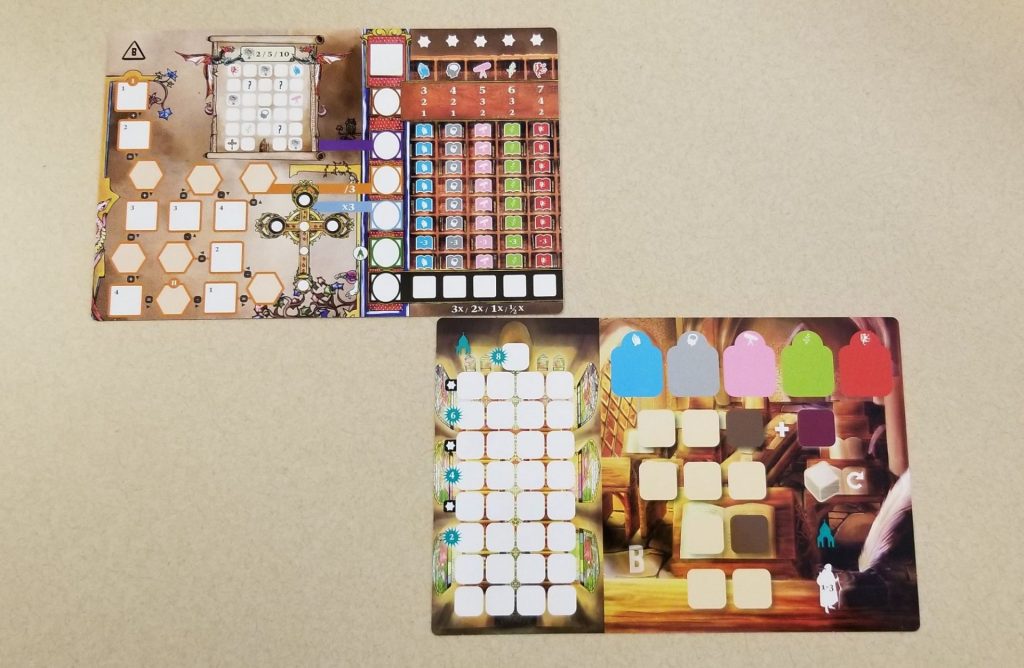
When playing with the B-Side, both the Monastery and Task cards should be turned to the same side. The rules for the B-Side are largely the same as the A-Side with just a few differences: the Novice track is no longer a linear track with optional branches. Now the players create their own tracks and are only able to earn bonuses by actually stopping on them. Also the book stack bonus values have changed along with the chapel bonuses. Lastly, the end-game scoring has been tweaked slightly. Each circle on the cross is worth 3 points instead of 2 and the left over Abbot influence is divided by 3 instead of 4. The B-Side is not available in solitaire mode.
Thoughts
In the original Biblios, there’s a deck of cards made up of books of varying colors and values, coins of different values, and cards that allow you to adjust the value dice that match the different book colors. The game’s split into two phases in which the players take turns drawing some cards, setting one aside for auction in the second phase, keeping one for themselves, and putting the rest into a public offering which the other players will draft from. At the end of the game, the players count up how much they have of each book type and only the people with the highest in each type earn points.
Biblios creates a lot of interesting tension and tactical decision space as the players are faced with having to find a balance between collecting money for the auction phase while, at the same time, collecting the cards needed to win them the game (not to mention having to decide which cards to put up for auction and which ones to just give away, a particularly difficult decision when you drew nothing but good cards). It’s a game with simple, elegant rules that belie the game’s depth and complexity. As such, it quickly became one of mine and my wife’s favorite games. When I heard there was a Biblios roll and write on the horizon, I was eager to try it out.
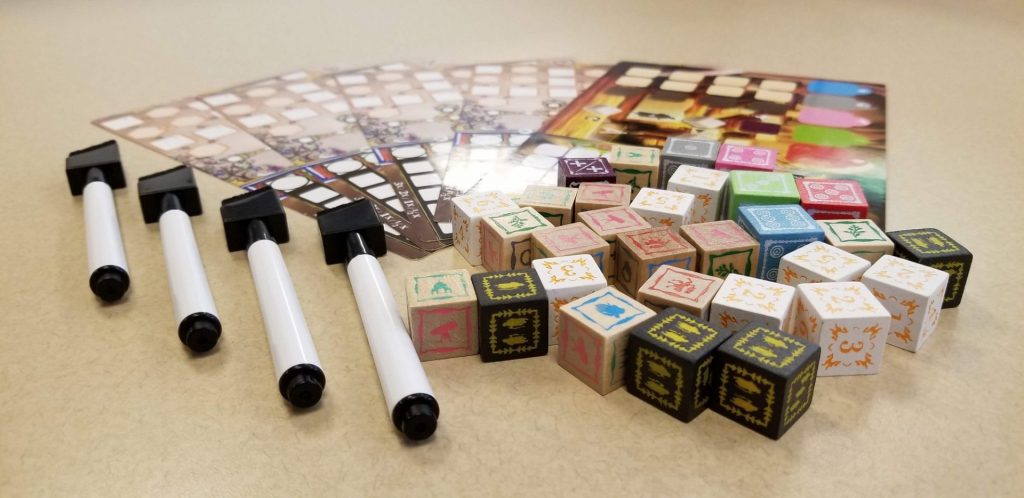
Let me start by gushing about this prototype that I received: it’s gorgeous. The game comes packaged in a box designed to look like an actual book. Opening the box I discovered a bevy of high-quality wooden dice, laminated game boards, and 4 dry erase markers with actual erasers on them (unheard of in a roll and write!). There’s also a rules booklet which, being a prototype, was unfortunately out-of-date by the time I received the game. While I’m not sure what the final product will be like, I can attest that no expense was spared in this prototype. If the quality of the game I received is indicative of where Dr. Finn is hoping to take this game, I have no doubt that the people that purchase the game will not be disappointed by the final production value.
But does Biblios Q&P measure up against its board game counterpart? Well, not as much as you might like it to.
Biblios Q&P is pretty standard as far as roll and writes go: you roll some dice (and optionally reroll them) and notate the results. That’s pretty much where things end, though. The only tactical decisions come from deciding whether to reroll just one single die or to reroll all of them and deciding which path you want your Novice to follow. Even deciding which task row to select during the Terce phase in Period II is largely out of your hands unless you’ve been lucky enough to have rolled a few Chapel dice along the way and gotten out ahead of the pack in turn order. If that isn’t the case, you’re just choosing from the leftovers.
Lucky enough. Those two words describe what I find most troublesome about Biblios Q&P. Aside from the Embellishment die and the one task row ability that allows you to turn a Book die into a Chapel die, there is no way for a player to manipulate any of the dice to produce a specific desired result. It’s all just random luck. Need a blue book to get the blue book bonus? Better pray that one rolls up. Novice two spaces away from reaching that last town? May the fates smile upon you. This lack of mitigation leaves me wanting. As a player, it makes me feel like I don’t have any real agency over anything that’s happening to me and it isn’t a feeling that I enjoy having when I’m playing a board game.
I will say, though, that Biblios Q&P is pretty rapid fire. A typical game only lasts for 10-15 minutes at the most from set up to tear down; a perfect filler game. But is it a filler game that I find myself longing to play over and over again? It’s a firm no. I miss the nail biting decision making and the player interaction from the board game version and there are many other filler games out there that give me that kind of satisfaction. Those kinds of decisions come with a price, though: time. If you’re just looking for something light and quick, Biblios Q&P could be the game for you. But, for me personally, it’s a pass. I like games with a lot of meat on their bones and this just isn’t a game that I can sink my teeth into.


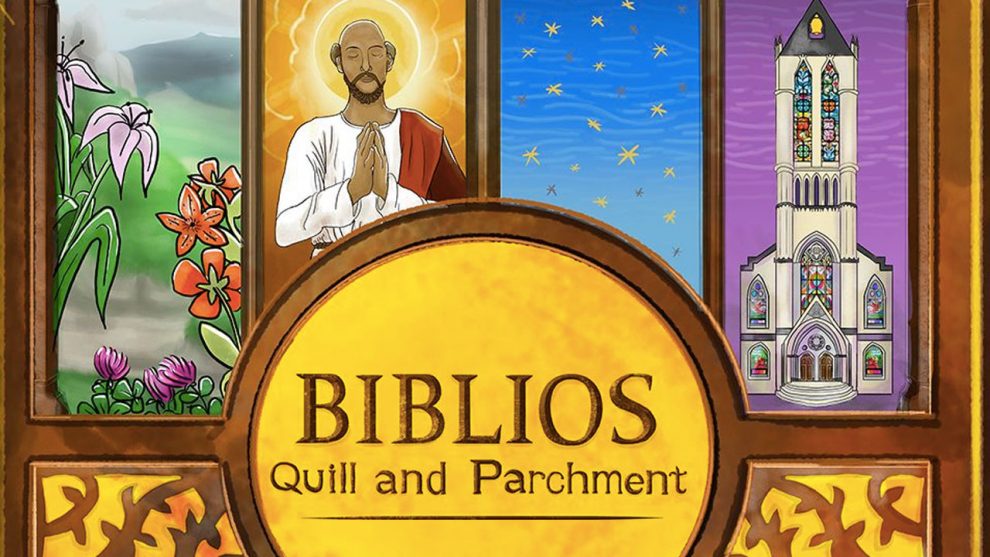

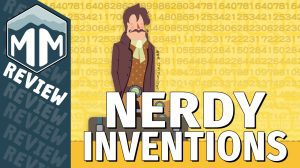







Add Comment